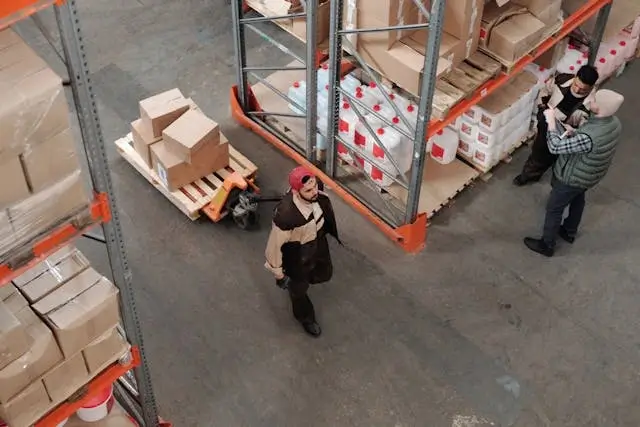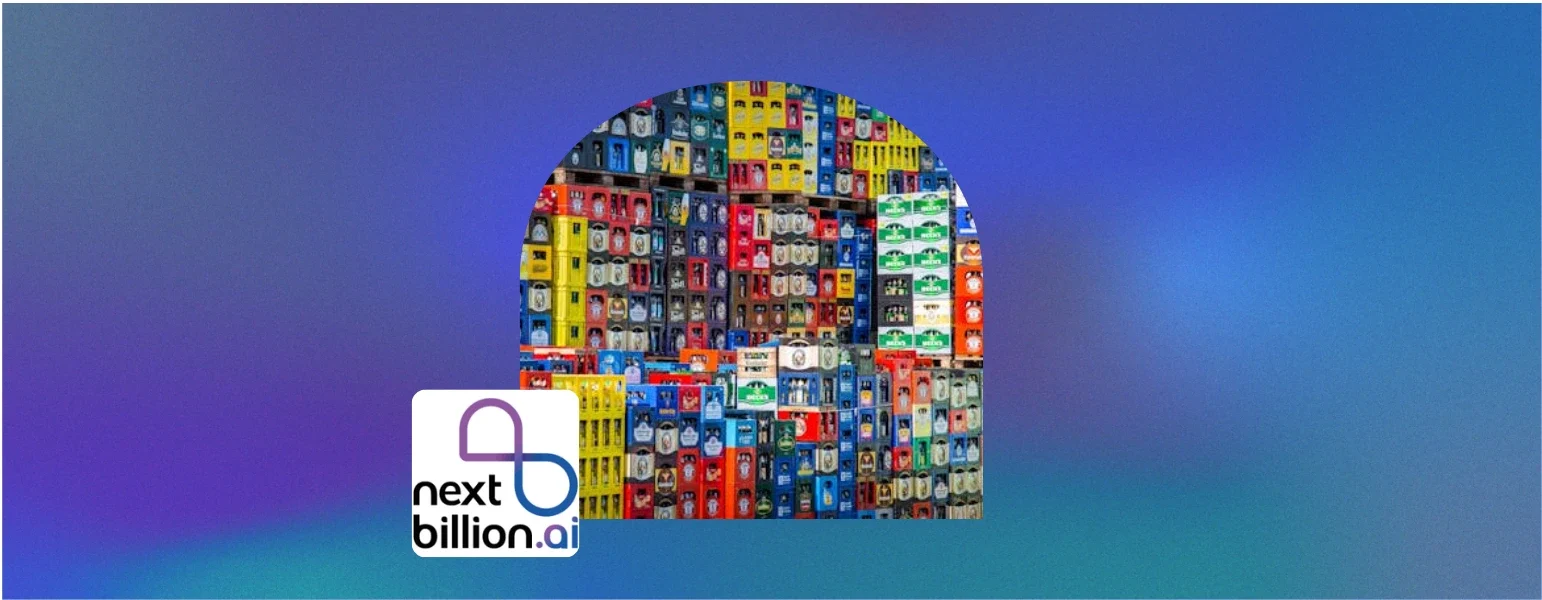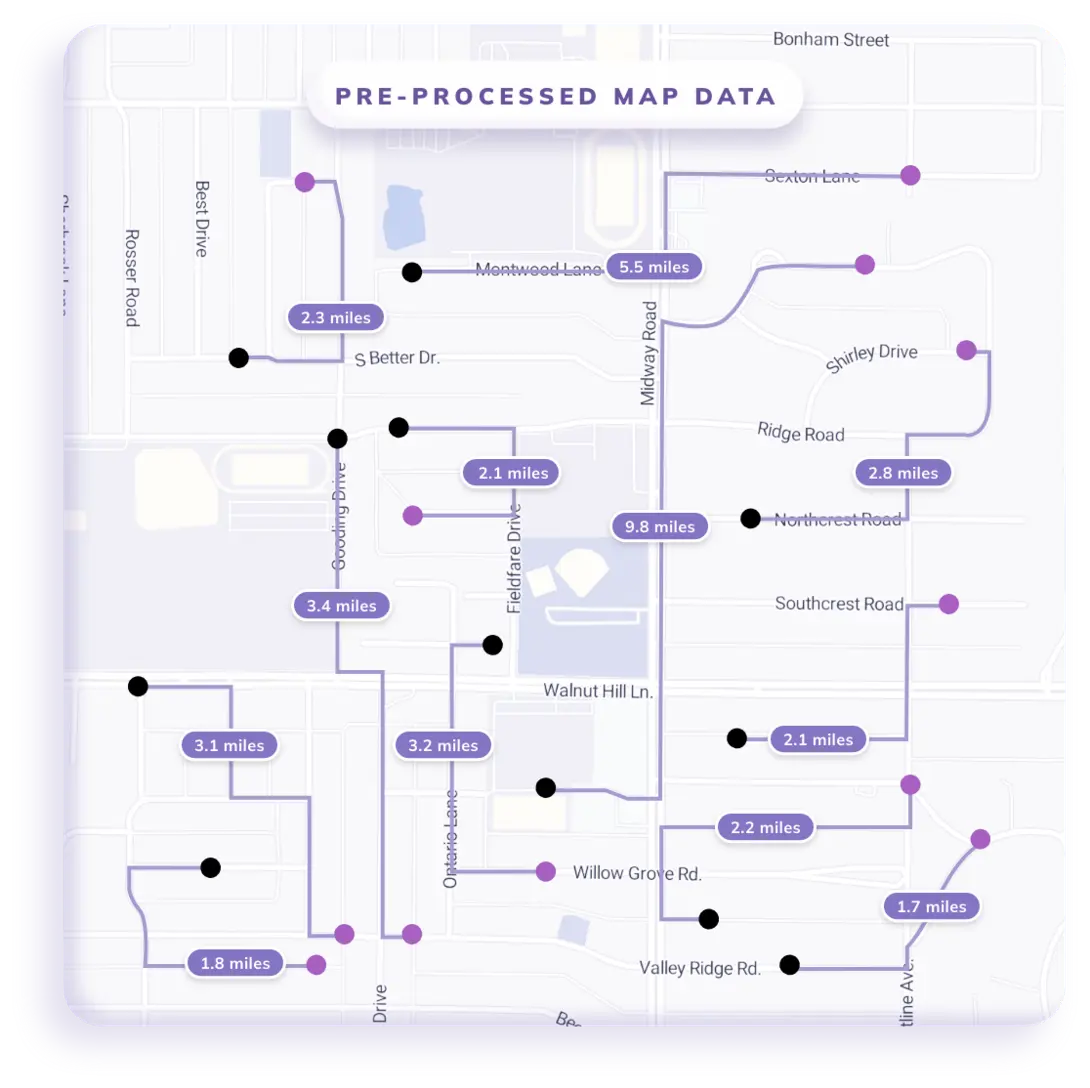

- BLOG
How Beverage Distributors Can Handle New Year Delivery Rush
Published: November 4, 2025
Route Optimization API
Optimize routing, task allocation and dispatch
Distance Matrix API
Calculate accurate ETAs, distances and directions
Directions API
Compute routes between two locations
Driver Assignment API
Assign the best driver for every order
Routing & Dispatch App
Plan optimized routes with 50+ Constraints
Product Demos
See NextBillion.ai APIs & SDKs In action
AI Route Optimization
Learns from Your Fleet’s Past Performance
Platform Overview
Learn about how Nextbillion.ai's platform is designed
Road Editor App
Private Routing Preferences For Custom Routing
On-Premise Deployments
Take Full Control of Your Maps and Routing
Trucking
Get regulation-compliant truck routes
Fleet Management
Solve fleet tracking, routing and navigation
Middle Mile Delivery
Optimized supply chain routes
Construction
Routes for Construction Material Delivery
Oil & Gas
Safe & Compliant Routing
Food & Beverage
Plan deliveries of refrigerated goods with regular shipments
Table of Contents

Every New Year season, beverage distributors face an intense demand surge. Both alcoholic and non-alcoholic beverage orders rise sharply as retailers, restaurants, and consumers prepare for celebrations. This sudden increase in volume strains distribution networks that must handle more deliveries in less time, often across urban areas already congested with holiday traffic.
As order volumes climb, so do the operational challenges. Delivery routes overlap, schedules slip, and fleets run short on drivers. Even small inefficiencies—like a missed turn or poorly sequenced route—can lead to delayed deliveries and frustrated customers.
This is where technology plays a critical role. Advanced location intelligence and route optimization systems can help distributors plan, monitor, and adapt delivery operations dynamically. By using real-time traffic, routing constraints, and predictive insights, distributors can minimize delays and improve overall efficiency during the New Year beverage delivery rush.
Let’s see how beverage distributors can leverage location technology to keep their operations smooth and customers happy during the rush.
The New Year period is one of the most demanding times for beverage distributors. Across cities, distribution networks must manage sharp increases in order volumes, limited fleet capacity, and urban mobility restrictions—all while maintaining delivery accuracy and timing. Understanding the core challenges behind these disruptions helps identify where operational systems often fall short.
Unpredictable demand surges
Order volumes can rise by 30–40% during the last two weeks of December. Despite historical data and forecasting models, last-minute retail restocks and bulk consumer orders often exceed predicted limits. This unpredictability leads to route congestion, scheduling conflicts, and higher turnaround times per trip.
Urban delivery constraints
City infrastructure presents additional difficulties. During the festive period, increased vehicle density, traffic restrictions near event zones, and reduced parking availability slow down last-mile operations. Delivery vehicles spend more time idling in congestion than moving between stops, reducing the number of deliveries completed within planned windows.
Complex delivery routes
Beverage delivery routes involve multiple drop-off points—retail stores, bars, and homes—each with distinct service time requirements. Drivers must also comply with fixed delivery windows, often within narrow time frames. The combination of route complexity and time sensitivity makes manual route planning impractical at scale.
Compliance and restrictions
For alcoholic beverages, delivery operations must follow legal constraints such as age verification, curfews, and geographic boundaries. Routes that unintentionally pass through restricted areas or exceed time limits can result in compliance issues and delayed shipments.
Fleet management stress
A limited number of vehicles and drivers adds further strain during high-demand periods. Extended working hours contribute to driver fatigue, while unoptimized dispatching leads to uneven workload distribution. These factors increase the likelihood of delivery errors and reduce operational efficiency.
Together, these beverage delivery challenges form a complex logistics problem that peaks during the festive season. Managing them effectively requires a system capable of adapting to real-time conditions, scaling route assignments, and maintaining compliance under pressure—key priorities in peak season logistics.
Traditional route planning systems, while sufficient for steady operations, often struggle during periods of intense demand such as the New Year rush. Static or manually created delivery routes fail to account for the variable nature of urban logistics, where traffic, order density, and delivery constraints change hour by hour.
Static routes can’t handle real-time traffic or order surges
Predefined delivery paths assume predictable conditions. During the holiday peak, however, sudden road closures, diversions, and increased traffic volume can render these routes inefficient within hours. When new orders arrive after dispatch, static systems are unable to re-sequence or insert them optimally.
Manual planning in spreadsheets or legacy tools
Some distributors still rely on spreadsheets or outdated routing software to plan deliveries. These tools lack the automation needed to process hundreds of constraints—such as delivery windows, capacity limits, or driver availability. Manual adjustments increase planning time and introduce human error, especially when handling last-minute changes.
No dynamic rerouting during execution
Once deliveries are underway, traditional systems rarely allow for dynamic route updates. Drivers encountering unexpected congestion or delivery cancellations have to rely on their own judgment, leading to inconsistent routes, missed deliveries, and underutilized fleet capacity.
Limited visibility across delivery zones and fleets
Without live tracking, dispatchers can’t see where vehicles are in real time. This makes it difficult to redistribute workloads, prioritize urgent deliveries, or identify bottlenecks as they occur. As a result, even well-planned routes can underperform when conditions change.
The inability to adapt dynamically in these scenarios highlights the limitations of static route planning. In contrast, dynamic routing and real-time delivery optimization technologies enable continuous adjustments to routing decisions based on current data. That’s where APIs built on location intelligence—like those from NextBillion.ai—make a real difference, providing the flexibility and precision that traditional systems cannot.
Modern mapping and location technology has become essential for handling large-scale, time-sensitive beverage deliveries during peak periods such as the New Year. These systems process real-time spatial data, traffic conditions, and delivery constraints to generate routes that are both efficient and adaptable. By integrating this intelligence into daily operations, distributors can reduce delivery delays, optimize fleet usage, and maintain consistent service quality.
Advanced Route Optimization APIs
Route optimization APIs can process thousands of delivery points simultaneously, accounting for constraints such as delivery windows, vehicle capacity, service times, and distance. Instead of manually sequencing stops, the system generates the most efficient routes across multiple vehicles and territories. This reduces redundant travel and improves delivery throughput during high-demand days.
Real-Time Traffic Data Integration
Traffic congestion is one of the main causes of delivery delays during the New Year period. By integrating live traffic data, mapping platforms can reroute vehicles automatically when road conditions change. The system considers congestion levels, accidents, and temporary closures, updating delivery paths in real time to preserve on-time performance.
Geofencing and Custom Territories
Geofencing allows distributors to define precise delivery boundaries, ensuring that drivers stay within permitted areas. It can also be used to avoid restricted or high-traffic zones, such as areas with alcohol delivery limitations or event-related road closures. Custom delivery territories help allocate resources efficiently and prevent overlaps between drivers.
Accurate ETAs and Live Tracking
Accurate Estimated Time of Arrival (ETA) calculations depend on both route data and real-time movement tracking. Location intelligence systems continuously monitor vehicle positions, recalculate ETAs based on traffic flow, and provide updates to dispatchers and customers. This transparency enhances coordination and driver accountability.
Driver Assignment APIs
Driver assignment systems use proximity, available capacity, and route priority to allocate tasks dynamically. Instead of manual dispatching, algorithms analyze which driver can handle a new or adjusted order most efficiently. This automation reduces idle time and ensures balanced workload distribution across the fleet.
By combining these components—route optimization, live traffic awareness, geospatial control, and intelligent dispatching—mapping technology provides a framework for scalable, data-driven operations. Beverage distributors can apply these same capabilities using NextBillion.ai’s location intelligence platform, which integrates routing, driver assignment, and real-time optimization to maintain delivery consistency even during the most demanding periods.

NextBillion.ai’s suite of APIs enables beverage distributors to manage the operational complexity that peaks during the New Year rush. Each API is designed to handle large-scale, constraint-based logistics—optimizing routes, automating driver assignment, and improving visibility across delivery zones. The following sections outline how these capabilities come together to maintain efficiency under pressure.
The Route Optimization API from NextBillion.ai is built to process thousands of delivery points in a single optimization request. It accounts for real-world delivery constraints such as vehicle capacity, delivery windows, and traffic conditions, enabling distributors to execute dense, time-bound delivery schedules efficiently.
Key features include:
1. Constraint-Based Optimization
2. Zone-Based Allocations
Zone-based allocations let planners restrict certain vehicles to predefined territories or geofences. For example, one fleet segment may serve only downtown deliveries while another handles suburban routes. This reduces overlapping coverage, minimizes travel distances, and leverages driver familiarity with specific neighborhoods.
3. Task Sequencing and Relations
Using relation types like in_sequence or in_direct_sequence, the API can maintain logical order among tasks. This is useful when specific delivery points must be visited consecutively, such as when multiple outlets belong to the same retail chain.
4. Order and Route Grouping
The order grouping feature combines multiple nearby deliveries into a single stop. This reduces unnecessary parking and navigation time, especially in apartment complexes or commercial hubs.
The route grouping feature ensures optimized execution by reducing route overlap and minimizing backtracking, particularly beneficial for large fleets serving multiple dense urban zones.
5. Custom Objectives and Equal Task Distribution
Distributors can customize optimization goals beyond minimizing travel distance. For instance, the system can aim to:
This flexibility supports workforce balance and improves resource utilization during peak demand.
6. Automated Re-Optimization
As new orders come in, the Route Optimization API can trigger automatic re-optimization, recalculating the best routes for ongoing operations without manual intervention. This ensures that even last-minute orders are efficiently integrated into the existing plan.
During New Year operations, road conditions change frequently due to traffic surges, event closures, or weather variations. The Directions API and optimization engine from NextBillion.ai provide real-time rerouting to maintain route efficiency.
When traffic density increases or a road becomes temporarily inaccessible, the system automatically recalculates alternative routes and updates ETAs for all active deliveries. These updated ETAs can then be communicated to both customers and drivers, maintaining transparency and reliability.
Real-time rerouting ensures:
The Driver Assignment API automates the process of matching available drivers to open delivery tasks based on defined constraints such as proximity, vehicle type, and delivery urgency. This capability is particularly useful for high-frequency order inflows common during holiday peaks.
Key capabilities include:
This system promotes dynamic routing and resource optimization by continuously evaluating available resources and reassigning drivers as conditions change. The result is higher fleet utilization, reduced idle time, and improved overall delivery flow.
Beverage distributors often operate under strict regional constraints, especially for alcoholic beverages. NextBillion.ai’s APIs allow for custom geospatial configurations that enhance compliance and route safety.
Using the Geofence API, planners can create:
These map layers can be integrated into optimization requests, enabling the system to automatically route vehicles around restricted or high-risk zones. The result is a delivery plan that aligns with legal and operational boundaries while maintaining route efficiency.
Visibility is critical for monitoring operations in real time. NextBillion.ai’s ecosystem supports centralized dashboards that integrate route, traffic, and fleet data.
Through a single interface, dispatch teams can:
This centralized control enables faster decision-making and better coordination between dispatchers and field drivers. By linking backend APIs with live operational dashboards, distributors gain a continuous feedback loop between planning and execution.
Managing high-volume beverage deliveries during New Year requires more than adding vehicles or extending shifts—it demands smart planning powered by data and automation. Here are a few practical steps to prepare your delivery network ahead of time:
1. Forecast Demand and Define Delivery Zones Early
Analyze historical delivery data from past holiday seasons to identify high-demand regions. Use zone-based allocations in NextBillion.ai’s Route Optimization API to predefine territories for each vehicle or driver, reducing overlaps and delays.
2. Integrate APIs for Real-Time Data and Route Updates
Connect your dispatch systems with APIs that ingest live traffic, weather, and order data. This integration helps dynamically reroute deliveries and adjust ETAs during peak hours.
3. Move from Static to Dynamic Route Planning
Replace fixed routes with adaptive routing models. NextBillion.ai’s real-time optimization allows planners to continuously adjust delivery paths as new orders come in or conditions change on the road.
4. Conduct Simulation Runs Before the Peak
Use NextBillion.ai’s route simulation tools to test scenarios like sudden order surges or road restrictions. These dry runs expose potential gaps in resource allocation and routing logic.
5. Measure and Refine After the Rush
Post-season analysis is critical. Evaluate KPIs such as average delivery time, missed ETAs, and vehicle utilization to fine-tune your optimization settings for future festive periods.
Handling the New Year delivery rush doesn’t have to mean chaos. With NextBillion.ai’s location-aware APIs, beverage distributors can deliver more orders, faster, and with precision.
Want to eliminate delivery chaos this New Year? Try NextBillion.ai’s Route Optimization and Driver Assignment APIs to plan, track, and deliver smarter.
Shivangi is a seasoned Technical Writer with a passion for simplifying technical concepts. With over 5 years of experience, she specializes in crafting clear and concise documentation for various technical products and platforms.